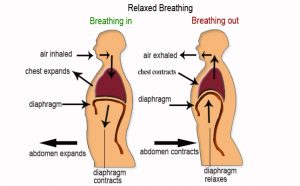It’s the exam, the job interview, or the dinner with the new in-laws. Whenever you are stressed, your breathing becomes shallow and hard, and your chest constricts. A deep breathing exercise can relax your chest muscle and return breathing to a normal pace.
Breathing and stress.
Breathing is especially impacted by stress. Lung tissue is fragile. It’s thin like tissue paper. Air expands the lung, filling it with oxygen, which is then picked up by the blood vessels around your lungs. These vessels carry oxygen to the rest of your body.
Normally, your lungs fill up with air and then deflate as oxygen is downloaded. The more stressed you get, the quicker your lungs inflate and deflate. If stress goes on for a while, the lungs hyperventilate. This means they are deflating faster than they are filling up with air. Your body isn’t getting enough oxygen and you might feel faint or black out.
Your diaphragm helps push the air out of your lungs, but your chest muscles also help lungs move. Chest muscles expand and contract the ribcage. Your chest muscle automatically contracts when you get tense. Your diaphragm pushes up, squeezing air out of your lungs. You feel that familiar “tightening of the chest”.
Gentle stretching and deep breathing relaxes chest muscle. But your lungs also need to de-stress. Deep breathing exercises help expand your lungs. As your lungs expand, more oxygen gets into your body. Fresh, oxygenated blood is pumped throughout your system, helping to relax tense muscles and get your breathing back to normal.
Breathing exercise
Having a good breathing exercise in your depression tool kit can help you fall asleep, soothe aching muscles, and get you into meditation faster. Learning a simple breathing exercise can be handy when you’re in a tense, stressful situation such as exams, a job interview, or dinner with the in laws.
Deep breathing exercise
- Stretch the rib cage and spine (overhead arm stretches, side to side, clasp hands in back and lift to fully open the chest area)
- Inhale through the nose (count of 3)-this allows the air to be filtered, moistened, and warmed.
- Breath slowly and in a relaxed manner – allow complete exhalation (exhale count of 4)
- Practice breathing exercises in several positions – for varied air distribution.
Upper chest breathing: Concentrate on filling the upper chest area with your breath. Place your hands on the chest area to focus on this particular area.
Abdominal breathing: Concentrate on filling the lower lungs with your breath and observe the abdomen rise and fall. Place your hands there to confirm expansion.
Lateral chest breathing: Concentrate on expanding your lower ribs with each breath. Place your hands on each side to help focus your attention to this area.
* The deep breathing exercise taken from Aromatherapy – A Lifetime Guide to Healing with Essential Oils by Valerie Gennari Cooksley (1996)
Visit me on Twitter @tereziafarkas
Visit my website http://www.tereziafarkas.com



